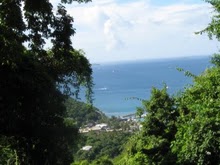 |
| Cormorant in flight |
When I finally got a close up view of this bird it landed in a pond near a busy transit station that I visit infrequently. I saw it fly into the pond directly ahead of me, as I was sitting soaking up the sun's rays and quietly contemplating the nearly empty pond. I knew immediately that I was seeing a new bird by its flight and shape, which got my attention like nothing else could. Reflexively I turned on both my camera and digital binos, but the bird dove immediately beneath the water, so that I was forced to bide my time before it popped it's head up above the surface. This bird can stay a long time under water let me tell you.
 |
| Nervous Cormorant |
The Cormorant seems to be a very shy and nervous bird, who is very much aware of his surroundings. It swam closer and closer toward me, as I waited patiently for a good shot with my camera, but as soon as I moved it shied away. So, at first, I tried to keep as still as possible, so as not to startle it into flight. As it nervously checked out the pond's suitability, it shied at every loud noise by either diving beneath the water or suddenly changing directions. This made it very difficult to take pictures, that and the fact that he was keeping a wary eye on me as well. Realizing this, I decided keeping still wouldn't result in any pictures at all and so, I was forced to move slowly and carefully if I also wanted to get a closer look at him.
 |
| More below the water than above |
I did see the Cormorant again on another occasion, this time in Miami, but only at a distance that was too far to allow for the taking of good, clear pictures. An interesting fact about Cormorants that I stumbled across while researching the bird, is that they can be tamed and trained to help human fisherman catch fish. This apparently is done in China. If you wish to learn more about the Cormorant just follow these links:
http://www.arkive.org/cormorant/phalacrocorax-carbo/info.html
http://animals.howstuffworks.com/birds/cormorant-info.htm
http://en.wikipedia.org/wiki/Double-crested_Cormorant
Susan











No comments:
Post a Comment